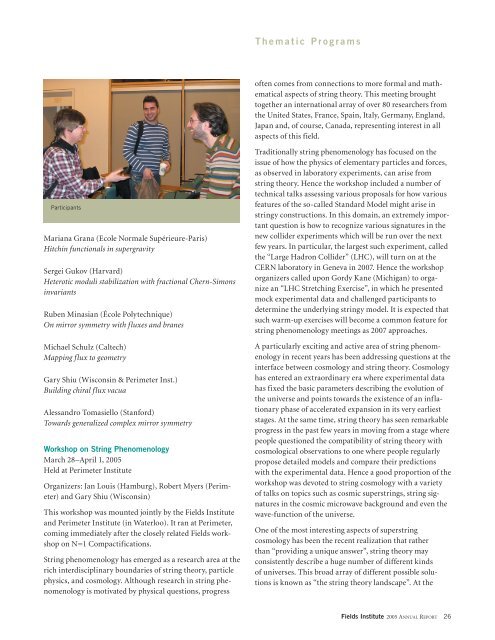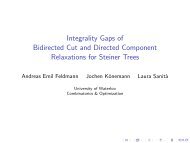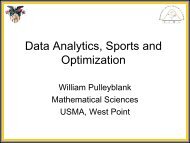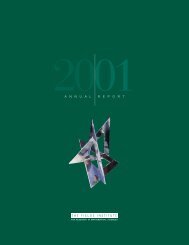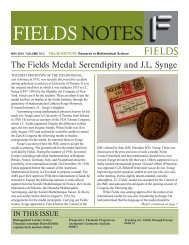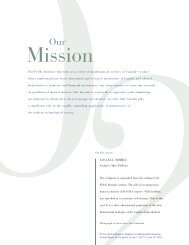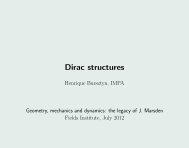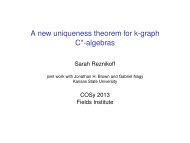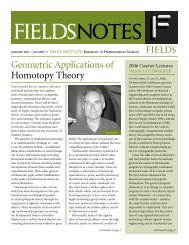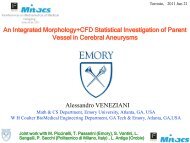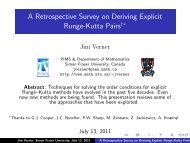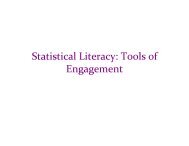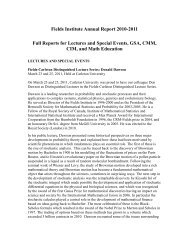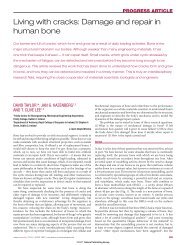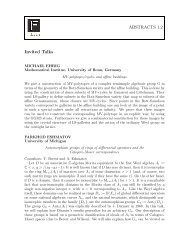Annual Report 2005 - Fields Institute - University of Toronto
Annual Report 2005 - Fields Institute - University of Toronto
Annual Report 2005 - Fields Institute - University of Toronto
You also want an ePaper? Increase the reach of your titles
YUMPU automatically turns print PDFs into web optimized ePapers that Google loves.
Participants<br />
Mariana Grana (Ecole Normale Supérieure-Paris)<br />
Hitchin functionals in supergravity<br />
Sergei Gukov (Harvard)<br />
Heterotic moduli stabilization with fractional Chern-Simons<br />
invariants<br />
Ruben Minasian (École Polytechnique)<br />
On mirror symmetry with fluxes and branes<br />
Michael Schulz (Caltech)<br />
Mapping flux to geometry<br />
Gary Shiu (Wisconsin & Perimeter Inst.)<br />
Building chiral flux vacua<br />
Alessandro Tomasiello (Stanford)<br />
Towards generalized complex mirror symmetry<br />
Workshop on String Phenomenology<br />
March 28–April 1, <strong>2005</strong><br />
Held at Perimeter <strong>Institute</strong><br />
Organizers: Jan Louis (Hamburg), Robert Myers (Perimeter)<br />
and Gary Shiu (Wisconsin)<br />
This workshop was mounted jointly by the <strong>Fields</strong> <strong>Institute</strong><br />
and Perimeter <strong>Institute</strong> (in Waterloo). It ran at Perimeter,<br />
coming immediately after the closely related <strong>Fields</strong> workshop<br />
on N=1 Compactifications.<br />
String phenomenology has emerged as a research area at the<br />
rich interdisciplinary boundaries <strong>of</strong> string theory, particle<br />
physics, and cosmology. Although research in string phenomenology<br />
is motivated by physical questions, progress<br />
T h e m a t i c P r o g r a m s<br />
<strong>of</strong>ten comes from connections to more formal and mathematical<br />
aspects <strong>of</strong> string theory. This meeting brought<br />
together an international array <strong>of</strong> over 80 researchers from<br />
the United States, France, Spain, Italy, Germany, England,<br />
Japan and, <strong>of</strong> course, Canada, representing interest in all<br />
aspects <strong>of</strong> this field.<br />
Traditionally string phenomenology has focused on the<br />
issue <strong>of</strong> how the physics <strong>of</strong> elementary particles and forces,<br />
as observed in laboratory experiments, can arise from<br />
string theory. Hence the workshop included a number <strong>of</strong><br />
technical talks assessing various proposals for how various<br />
features <strong>of</strong> the so-called Standard Model might arise in<br />
stringy constructions. In this domain, an extremely important<br />
question is how to recognize various signatures in the<br />
new collider experiments which will be run over the next<br />
few years. In particular, the largest such experiment, called<br />
the “Large Hadron Collider” (LHC), will turn on at the<br />
CERN laboratory in Geneva in 2007. Hence the workshop<br />
organizers called upon Gordy Kane (Michigan) to organize<br />
an “LHC Stretching Exercise”, in which he presented<br />
mock experimental data and challenged participants to<br />
determine the underlying stringy model. It is expected that<br />
such warm-up exercises will become a common feature for<br />
string phenomenology meetings as 2007 approaches.<br />
A particularly exciting and active area <strong>of</strong> string phenomenology<br />
in recent years has been addressing questions at the<br />
interface between cosmology and string theory. Cosmology<br />
has entered an extraordinary era where experimental data<br />
has fixed the basic parameters describing the evolution <strong>of</strong><br />
the universe and points towards the existence <strong>of</strong> an inflationary<br />
phase <strong>of</strong> accelerated expansion in its very earliest<br />
stages. At the same time, string theory has seen remarkable<br />
progress in the past few years in moving from a stage where<br />
people questioned the compatibility <strong>of</strong> string theory with<br />
cosmological observations to one where people regularly<br />
propose detailed models and compare their predictions<br />
with the experimental data. Hence a good proportion <strong>of</strong> the<br />
workshop was devoted to string cosmology with a variety<br />
<strong>of</strong> talks on topics such as cosmic superstrings, string signatures<br />
in the cosmic microwave background and even the<br />
wave-function <strong>of</strong> the universe.<br />
One <strong>of</strong> the most interesting aspects <strong>of</strong> superstring<br />
cosmology has been the recent realization that rather<br />
than “providing a unique answer”, string theory may<br />
consistently describe a huge number <strong>of</strong> different kinds<br />
<strong>of</strong> universes. This broad array <strong>of</strong> different possible solutions<br />
is known as “the string theory landscape”. At the<br />
<strong>Fields</strong> <strong>Institute</strong> <strong>2005</strong> ANNUAL REPORT 26


